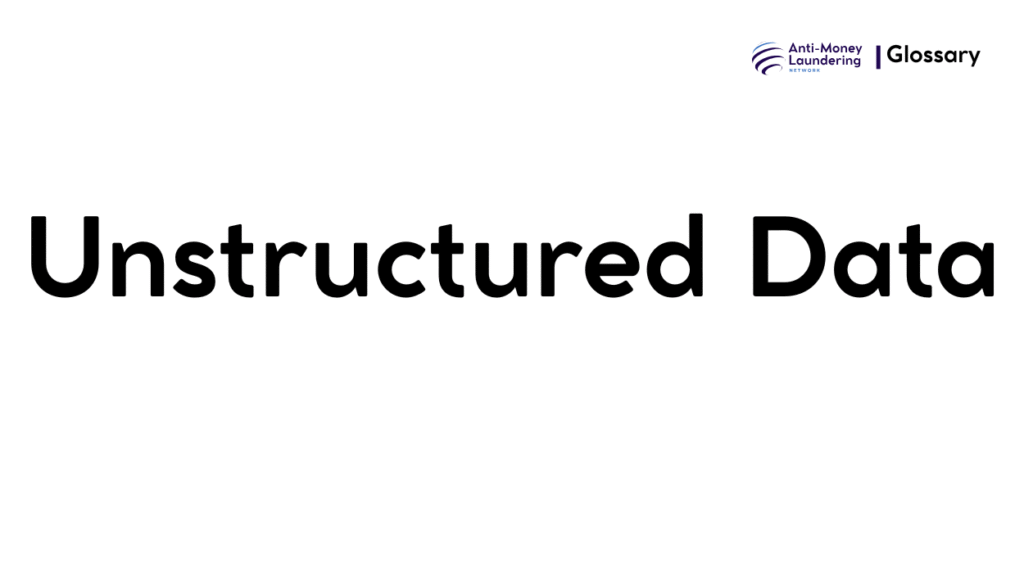Understanding unstructured data within the context of Anti-Money Laundering (AML) is crucial for compliance officers and financial institutions aiming to effectively combat financial crime. This comprehensive guide covers the definition, regulatory background, practical applications, challenges, and best practices surrounding unstructured data in AML.
Definition
Unstructured data in AML refers to the vast volume of digital information that does not follow a predefined format or schema, making it difficult to store in traditional relational databases. Unlike structured data — which includes transactional records or customer profiles held in tables — unstructured data includes textual documents, emails, chat logs, trade documents, call recordings, images, and more. Because it lacks a fixed organization, unstructured data requires specialized analytical tools to extract meaningful insights.
Purpose and Regulatory Basis
Role in AML
Financial institutions gather and analyze unstructured data as part of their AML programs to improve detection of suspicious activities that might otherwise remain hidden in structured data alone. Many illicit behaviors, complex transactions, or red flags can be embedded in free-form text or multimedia sources, making the use of unstructured data essential for comprehensive risk assessments.
Regulatory Expectations
Key global and national AML regulations underscore the importance of exploiting all relevant data:
- FATF Recommendations emphasize comprehensive customer due diligence (CDD) and monitoring, encouraging effective use of all available data.
- The USA PATRIOT Act mandates enhanced scrutiny and record-keeping that often involves unstructured documents such as communications or trade paperwork.
- The EU Anti-Money Laundering Directives (AMLD) require institutions to implement risk-based approaches that include analysis of unstructured data sources.
These regulations collectively push organizations to develop capabilities to process and analyze unstructured data within their AML controls to comply effectively.
When and How it Applies
Real-World Use Cases
- Customer Due Diligence (CDD): Analyzing emails, chat logs, and call transcripts to derive behavioral insights and verify customer information.
- Transaction Monitoring: Extracting details from free-text narratives in wire transfers or trade documents to detect anomalies such as inconsistent pricing or dual-use goods.
- Investigations: Leveraging case notes, SARs (Suspicious Activity Reports), and law enforcement requests stored as unstructured data for deeper analysis.
Triggers for Analysis
AML teams are often prompted to analyze unstructured data when:
- Structured data fails to flag suspicious patterns.
- External negative news or media reports become available.
- Regulatory or law enforcement inquiries involve unstructured communication.
Types or Variants
Unstructured data in AML can be classified into several forms:
- Textual Data: Emails, chat transcripts, reports, case management notes.
- Multimedia Data: Voice recordings, video files from surveillance or customer interactions.
- Documentary Data: Trade documents such as bills of lading, letters of credit, commercial invoices.
- Open-Source Intelligence: News articles, social media posts, public databases.
There is also semi-structured data, which contains some organizational markers (like metadata or tags) but not enough to fit rigid relational schemas.
Procedures and Implementation
Systems and Technologies
Institutions implement advanced analytics platforms that integrate AI and natural language processing (NLP) techniques for:
- Text mining to extract entities and relationships.
- Pattern recognition in communications or document repositories.
- Sentiment and risk scoring based on qualitative data.
Controls and Processes
- Establish data governance frameworks to identify and catalog unstructured data assets.
- Embed unstructured data analysis within ongoing AML risk assessment workflows.
- Train staff on interpreting insights derived from unstructured sources.
- Regularly update analytical models to handle evolving data formats and typologies.
Impact on Customers/Clients
Rights and Restrictions
- Customers should be made aware of the data types institutions collect and analyze.
- Privacy rights must be respected, especially around communication data like emails or calls.
- Proper consent and data protection measures are required under regulations such as GDPR.
Customer Interactions
- Enhanced scrutiny may lead to additional requests for documentation or information.
- Improved detection can reduce delays and false positives, leading to smoother customer experiences.
Duration, Review, and Resolution
- Unstructured data related to AML must be retained in accordance with jurisdictional regulatory timeframes, often 5–10 years.
- Periodic review of stored unstructured data is necessary to ensure relevance and compliance.
- Institutions must have processes to update or delete data responsibly once retention periods expire.
Reporting and Compliance Duties
- Document the use and analysis of unstructured data in AML policies.
- Ensure reporting systems can incorporate findings from unstructured data analysis, especially in SAR filings.
- Maintain audit trails and metadata about unstructured data handling.
- Non-compliance can result in significant regulatory penalties, fines, and reputational damage.
Related AML Terms
- Know Your Customer (KYC): Relies on both structured and unstructured data to verify client identities and assess risks.
- Suspicious Activity Reports (SARs): Often entail unstructured narrative descriptions.
- Transaction Monitoring: Uses unstructured data to supplement alerts from structured data analysis.
- Negative News Screening: Analyzes open source unstructured information.
Challenges and Best Practices
Challenges
- Volume and variety of unstructured data can be overwhelming.
- Difficulty in standardizing analysis across different formats and sources.
- Risks related to data privacy and protecting sensitive information.
- Integration with legacy AML systems.
Best Practices
- Employ AI and machine learning tools tailored for AML.
- Maintain cross-functional teams including compliance, IT, and data science.
- Adopt scalable data storage solutions, such as data lakes.
- Conduct ongoing training and validation of models.
- Implement clear privacy and security controls.
Recent Developments
- Increased use of Artificial Intelligence and Natural Language Processing to automate the extraction of insights from unstructured text and multimedia.
- Adoption of cloud-based data lakes for scalable, secure management of unstructured data.
- Growing regulatory focus on technology controls in AML and data privacy.
- Emergence of new data sources like social media analytics and open-source intelligence platforms.
Unstructured data represents a critical frontier in AML compliance. Properly harnessed, it enriches financial institutions’ capabilities to detect, investigate, and report suspicious activity beyond traditional structured data methods. With mounting regulatory demands and evolving criminal techniques, mastering unstructured data analytics is indispensable for effective AML programs.

